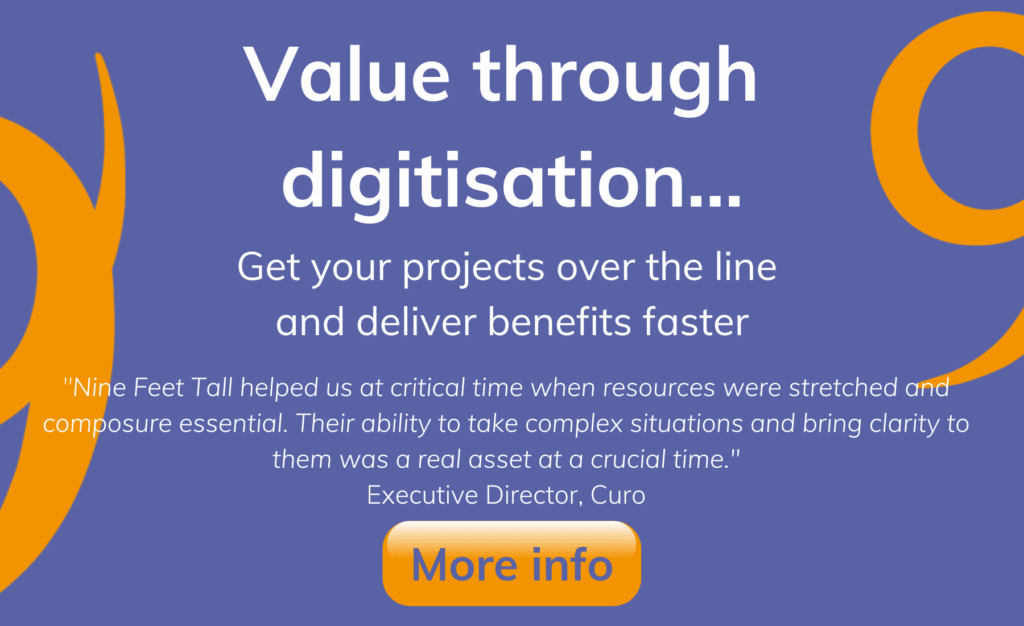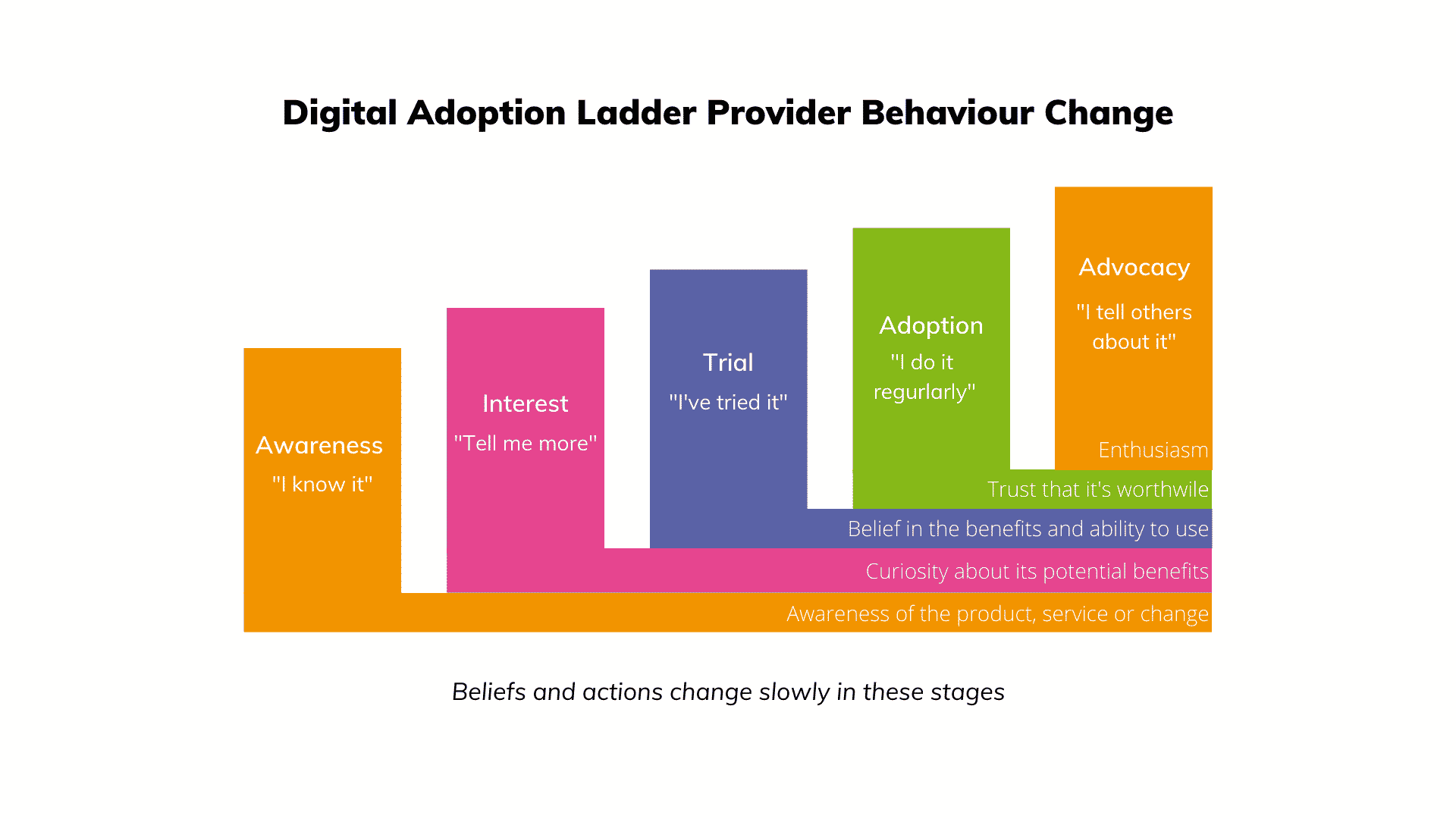This guide to digital adoption will:
- Provide strategies that will help increase ROI for your business
- Explain what digital adoption really means
- Highlight methods to increase the effectiveness of your adoption
- Draw from lived experience of challenges within digital adoption and the methods that actually work
What is digital adoption?
Digital adoption is the process whereby an organisation fully utilises and leverages all tools and technologies to maximise the return on investment and drive innovation. Without adoption there is no transformation.
This can be from an external customer perspective, but also from an internal employee position. The latter is key, as ultimately you cannot best serve customers if your employees are not set up for success. Digital adoption includes a large element of change management and digital transformation. However, true adoption of new digital assets will not be met without the implementation of change processes.
A change in mentality and approach towards the new technology is vital, to ensure users are capable and willing to utilise it. Essentially, if all the available features are not employed by users, then simply implementing new technology is somewhat useless, and a huge waste of resources. It may not surprise you then that successful transformation depends on the leadership mindset and its strategies for adoption (Bonch, 2016).
As shown in a recent case study we conducted, employees only use approximately 40% of the features of new software applications and this dramatically reduces the ROI derived from the implementation of new software.
Employees are still spending an average of 22 minutes a day trying to figure out how to accomplish tasks while working with new applications, as demonstrated by a study published on Harvard Business Review
It is clear that you cannot have successful digital transformation without digital adoption.
 How to increase digital adoption?
How to increase digital adoption?
So why do businesses struggle, and how can true adoption be met?
Having a clear digital adoption strategy is key when making any digital transformation. As aforementioned, this includes change management processes to ensure technology is truly adopted, and the benefit/value fully met.
Firstly, comes understanding and awareness. Users need to be aware of the benefits of the new digital processes or tools and the reason for the change, in other words – understand the why.
Secondly, training around all the features of new technology and applications is vital. Additionally, continuous training is important, which can be aided with a culture of lifelong learning.
Thirdly, the process can be improved with an adaptable and flexible workforce, so these skills should be sought when recruiting new employees. A workforce with a perfectly aligned skillset also includes the skill shifts that may be required to carry out new tasks and interact with new interfaces.
A lifelong learning culture also includes an efficient knowledge transfer procedure. As mentioned in Pluralsights Report on the fourth industrial revolution, staff training and employee development plans will become the centre of the business strategy of major corporations by 2025.
There are four types of activities that will need to considered:
- Preparedness Activity
- Community Influencer Activity
- Risk Mitigation Activity
- User Adoption Activity
What are the challenges of digital adoption?
The biggest challenges related to adoption are resistance to change and a legacy culture, in today’s day and age these are both competing for people’s attention. Additionally, business software is more complicated than regular customer software which does not aid the employee experience. Often, businesses use too much software, and this coupled with poor training reduces the success of digital adoption as employees can be overwhelmed and less likely to interact with the software and new ways of working.
From a customer perspective it can also be difficult get to grips with new software. Businesses can use educational campaigns, such as print and online ads, email marketing campaigns and social media campaigns, and improve access to support alongside constant promotion of new and improved features to ensure the customer has the latest knowledge and skills to use the software effectively. On the flip side of this, bad support around newly implemented technologies can negatively impact digital adoption amongst customers. It’s important to get this right and keep the users up to date.
What is a digital adoption platform?
The adoption of digital assets and processes can be made easier with digital adoption platforms. A digital adoption platform is a software layer integrated on top of another software application or website with guidance and training for users, often including step-by-step interactive support and useful knowledge content. These platforms are useful and can be effective for guaranteeing productivity and a great employee experience. The interactive element especially helps with this.
A digital adoption platform will help you get the most out of applications by reducing the friction of using new tools and processes whilst increasing the accuracy of task completion. Also available are helpful analytics to measure overall adoption through tracking features that provide metrics such as engagement with support content, time spent on tasks and the value of software itself.
Digital adoptions models that work
A digital adoption model acts as a funnel or ladder that allows you to track the level of adoption. The ladder begins at the bottom (no adoption) to the topmost level (completely adopted), and the aim is to move up the ladder. Additionally, the numbers normally reduce as you move up the ladder and this reduction is according to “Conversion Ratios” from each lower level to the next higher level. Each level on the ladder may have specific properties such as the volume of products purchased or percentage of engagement with new software at that level. A digital adoption model can be used in various scenarios, including internal employee change adoption, customer loyalty and your sales pipeline.
 Change management programmes that hinge on clear communication, benefits, and cultural changes need to be coupled with a digital adoption model and strategy. This will aid your fight against any resistance to change. Agile solutions can be used to provide continuous performance support that compensates for the need for training and retraining. Alongside this ensuring continuous learning initiatives will boost adoption.
Change management programmes that hinge on clear communication, benefits, and cultural changes need to be coupled with a digital adoption model and strategy. This will aid your fight against any resistance to change. Agile solutions can be used to provide continuous performance support that compensates for the need for training and retraining. Alongside this ensuring continuous learning initiatives will boost adoption.
Lastly, investing in people and their digital know-how is the most essential element to guarantee scalability and sustainability. Appointing digital adoption officers or change champions who have the task of ensuring that employees are continuously being trained on new technologies, will increase the overall success and ROI of digital initiatives while optimizing the Total Cost of Ownership (TCO).
Digital adoption starts with a conversation, let’s have a chat.

